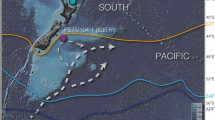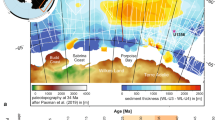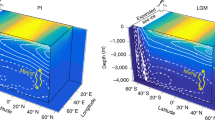Abstract
Growing evidence suggests that the low atmospheric CO2 concentration of the ice ages resulted from enhanced storage of CO2 in the ocean interior, largely as a result of changes in the Southern Ocean1. Early in the most recent deglaciation, a reduction in North Atlantic overturning circulation seems to have driven CO2 release from the Southern Ocean2,3,4,5, but the mechanism connecting the North Atlantic and the Southern Ocean remains unclear. Biogenic opal export in the low-latitude ocean relies on silicate from the underlying thermocline, the concentration of which is affected by the circulation of the ocean interior. Here we report a record of biogenic opal export from a coastal upwelling system off the coast of northwest Africa that shows pronounced opal maxima during each glacial termination over the past 550,000 years. These opal peaks are consistent with a strong deglacial reduction in the formation of silicate-poor glacial North Atlantic intermediate water2 (GNAIW). The loss of GNAIW allowed mixing with underlying silicate-rich deep water to increase the silicate supply to the surface ocean. An increase in westerly-wind-driven upwelling in the Southern Ocean in response to the North Atlantic change has been proposed to drive the deglacial rise in atmospheric CO2 (refs 3, 4). However, such a circulation change would have accelerated the formation of Antarctic intermediate water and sub-Antarctic mode water, which today have as little silicate as North Atlantic Deep Water and would have thus maintained low silicate concentrations in the Atlantic thermocline. The deglacial opal maxima reported here suggest an alternative mechanism for the deglacial CO2 release5,6. Just as the reduction in GNAIW led to upward silicate transport, it should also have allowed the downward mixing of warm, low-density surface water to reach into the deep ocean. The resulting decrease in the density of the deep Atlantic relative to the Southern Ocean surface promoted Antarctic overturning, which released CO2 to the atmosphere.
This is a preview of subscription content, access via your institution
Access options
Subscribe to this journal
Receive 51 print issues and online access
$199.00 per year
only $3.90 per issue
Buy this article
- Purchase on Springer Link
- Instant access to full article PDF
Prices may be subject to local taxes which are calculated during checkout




Similar content being viewed by others
References
Sigman, D. M., Hain, M. P. & Haug, G. H. The polar ocean and glacial cycles in atmospheric CO2 concentration. Nature 466, 47–55 (2010)
McManus, J. F., Francois, R., Gherardi, J. M., Keigwin, L. D. & Brown-Leger, S. Collapse and rapid resumption of Atlantic meridional circulation linked to deglacial climate changes. Nature 428, 834–837 (2004)
Toggweiler, J. R. & Lea, D. W. Temperature differences between the hemispheres and ice age climate variability. Paleoceanography 25, PA2212 (2010)
Anderson, R. F. et al. Wind-driven upwelling in the Southern Ocean and the deglacial rise in atmospheric CO2 . Science 323, 1443–1448 (2009)
Sigman, D. M., de Boer, A. M. & Haug, G. H. in Ocean Circulation: Mechanisms and Impacts (eds Schmittner, A., Chiang, J. C. H. & Hemming, S. R. ) 335–349 (Geophys. Monogr. Ser. 173, Am. Geophys. Union, 2007)
Broecker, W. S. Paleocean circulation during the last deglaciation: a bipolar seesaw? Paleoceanography 13, 119–121 (1998)
Rickaby, R. E. M. & Elderfield, H. Evidence from the high-latitude North Atlantic for variations in Antarctic Intermediate water flow during the last deglaciation. Geochem. Geophys. Geosyst. 6, Q05001 (2005)
Came, R. E., Oppo, D. W., Curry, W. B. & Lynch-Stieglitz, J. Deglacial variability in the surface return flow of the Atlantic meridional overturning circulation. Paleoceanography 23, PA1217 (2008)
Xie, R. C., Marcantonio, F. & Schmidt, M. W. Deglacial variability of Antarctic Intermediate Water penetration into the North Atlantic from authigenic neodymium isotope ratios. Paleoceanography 27, PA3221 (2012)
Came, R. E., Oppo, D. W. & Curry, W. B. Atlantic Ocean circulation during the Younger Dryas: insights from a new Cd/Ca record from the western subtropical South Atlantic. Paleoceanography 18, 1086 (2003)
Sarmiento, J. L., Gruber, N., Brzezinski, M. A. & Dunne, J. P. High-latitude controls of thermocline nutrients and low latitude biological productivity. Nature 427, 56–60 (2004)
Gnanadesikan, A. & Toggweiler, J. R. Constraints placed by silicon cycling on vertical exchange in general circulation models. Geophys. Res. Lett. 26, 1865–1868 (1999)
Tiedemann, R., Sarnthein, M. & Stein, R. in Proc. ODP Sci. Res. Vol. 108 (eds Ruddiman, W. F. & Sarnthein, M. ) 241–277 (Texas A & M Univ., 1989)
Harris, P. G. et al. Chlorin accumulation rate as a proxy for Quaternary marine primary productivity. Nature 383, 63–65 (1996)
Eglinton, G. et al. Molecular record of secular sea-surface temperature-changes on 100-year timescales for glacial terminations I, II and IV. Nature 356, 423–426 (1992)
Adkins, J., deMenocal, P. & Eshel, G. The “African humid period” and the record of marine upwelling from excess Th-230 in Ocean Drilling Program Hole 658C. Paleoceanography 21, PA4203 (2006)
Romero, O. E., Kim, J. H. & Donner, B. Submillennial-to-millennial variability of diatom production off Mauritania, NW Africa, during the last glacial cycle. Paleoceanography 23, PA3218 (2008)
Bradtmiller, L. I., Anderson, R. F., Fleisher, M. Q. & Burckle, L. H. Opal burial in the equatorial Atlantic Ocean over the last 30 ka: implications for glacial-interglacial changes in the ocean silicon cycle. Paleoceanography 22, PA4216 (2007)
Gil, I. M., Keigwin, L. D. & Abrantes, F. G. Deglacial diatom productivity and surface ocean properties over the Bermuda Rise, northeast Sargasso Sea. Paleoceanography 24, PA4101 (2009)
Jaccard, S. L. et al. The distinct roles of the Antarctic and Subantarctic Zones in ocean productivity and atmospheric CO2 over the past million years. Science (in the press)
Marchitto, T. M., Oppo, D. W. & Curry, W. B. Paired benthic foraminiferal Cd/Ca and Zn/Ca evidence for a greatly increased presence of Southern Ocean Water in the glacial North Atlantic. Paleoceanography 17, 1038 (2002)
Brzezinski, M. A. et al. A switch from Si(OH)4 to NO3 − depletion in the glacial Southern Ocean. Geophys. Res. Lett. 29, 5 (2002)
Jouzel, J. et al. Orbital and millennial Antarctic climate variability over the past 800,000 years. Science 317, 793–796 (2007)
Oppo, D. W. & Curry, W. B. Deep Atlantic circulation during the Last Glacial Maximum and deglaciation. Nature Edu. Knowl. 3, 1 (2012)
Hayes, C. T., Anderson, R. F. & Fleisher, M. Q. Opal accumulation rates in the equatorial Pacific and mechanisms of deglaciation. Paleoceanography 26, PA1207 (2011)
Marshall, J. & Speer, K. Closure of the meridional overturning circulation through Southern Ocean upwelling. Nature Geosci. 5, 171–180 (2012)
Levitus, S. in NOAA Atlas NESDIS 68 184 (US Govt Printing Office, 2009)
Stott, L., Timmermann, A. & Thunell, R. Southern hemisphere and deep-sea warming led deglacial atmospheric CO2 rise and tropical warming. Science 318, 435–438 (2007)
Shakun, J. D. et al. Global warming preceded by increasing carbon dioxide concentrations during the last deglaciation. Nature 484, 49–54 (2012)
Schlitzer, R. Electronic atlas of WOCE hydrographic and tracer data now available. Eos Trans. AGU 81, 45 (2000)
Siegenthaler, U. et al. Stable carbon cycle-climate relationship during the late Pleistocene. Science 310, 1313–1317 (2005)
Tjallingii, R. et al. Coherent high- and low-latitude control of the northwest African hydrological balance. Nature Geosci. 1, 670–675 (2008)
Mortlock, R. A. & Froelich, P. N. A simple method for the rapid-determination of biogenic opal in pelagic marine-sediments. Deep-Sea Res. 36, 1415–1426 (1989)
Sarnthein, M. & Tiedemann, R. Younger Dryas-style cooling events at glacial terminations I-VI at ODP site 658: associated benthic delta 13C anomalies constrain meltwater hypothesis. Paleoceanography 5, 1041–1055 (1990)
Lisiecki, L. E. & Raymo, M. E. A. Pliocene-Pleistocene stack of 57 globally distributed benthic delta O-18 records. Paleoceanography 20, PA1003 (2005)
deMenocal, P. et al. Abrupt onset and termination of the African Humid Period: rapid climate responses to gradual insolation forcing. Quat. Sci. Rev. 19, 347–361 (2000)
Paillard, D., Labeyrie, L. & Yiou, P. Macintosh program performs time-series analysis. Eos Trans. AGU 77, 379 (1996)
Jullien, E. et al. Low-latitude “dusty events” vs. high-latitude “icy Heinrich events”. Quat. Res. 68, 379–386 (2007)
Acknowledgements
This research used samples provided by the ODP, which is sponsored by the US NSF and participating countries under the management of the Joint Oceanographic Institutions. XRF data were acquired at the XRF Core Scanner Lab at MARUM – Center for Marine Environmental Sciences, University of Bremen, with support from the DFG-Leibniz Center for Surface Process and Climate Studies at the University of Potsdam. Further support was provided by the US NSF through grant OCE-1060947 to D.M.S. and by NSERC and CFCAS to R.F. We thank V. Lukies for XRF scanning technical support and T. Westerhold for help in deriving the new composite depth. M. Soon and T. Kane are acknowledged for opal and excess 230Th measurements, respectively, in core MD03-2705.
Author information
Authors and Affiliations
Contributions
A.N.M. and G.H.H. designed the study; A.N.M. collected the XRF data at ODP Site 658; U.R. facilitated and oversaw the XRF scanning; R.F. contributed the 230Th-normalized opal flux data; R.T. provided data and background knowledge on Site 658; A.N.M., S.L.J. and A.M.G. undertook the comparisons with Southern Ocean data; A.N.M., D.M.S. and G.H.H. wrote the first draft of the manuscript; and K.A.G. and L.C.P. provided input regarding tropical Atlantic observations. All authors contributed to the interpretation and the preparation of the final manuscript.
Corresponding author
Ethics declarations
Competing interests
The authors declare no competing financial interests.
Supplementary information
Supplementary Information
This file contains Supplementary Figures 1-3, which includes a correction of the ln (Si/Al)-based opal record from ODP Site 658 for changes in grain size using ln (Zr/Al) data, a comparison of the ln (Si/Al) record to other data from Site 658 including close-ups of the last five glacial terminations, and information on how the new stratigraphy for Site 658 was derived. This file also contains Supplementary Discussions 1 and 2, which provide information about (1) the potential effects of preservation on opal concentration and (2) previously published evidence for intermediate water mass structure, and Supplementary References. (PDF 1055 kb)
Rights and permissions
About this article
Cite this article
Meckler, A., Sigman, D., Gibson, K. et al. Deglacial pulses of deep-ocean silicate into the subtropical North Atlantic Ocean. Nature 495, 495–498 (2013). https://doi.org/10.1038/nature12006
Received:
Accepted:
Published:
Issue Date:
DOI: https://doi.org/10.1038/nature12006
This article is cited by
-
Climate-controlled submarine landslides on the Antarctic continental margin
Nature Communications (2023)
-
A potential feedback loop underlying glacial-interglacial cycles
Climate Dynamics (2021)
-
The nature of deep overturning and reconfigurations of the silicon cycle across the last deglaciation
Nature Communications (2020)
-
Increased nutrient supply to the Southern Ocean during the Holocene and its implications for the pre-industrial atmospheric CO2 rise
Nature Geoscience (2018)
-
Coherent deglacial changes in western Atlantic Ocean circulation
Nature Communications (2018)
Comments
By submitting a comment you agree to abide by our Terms and Community Guidelines. If you find something abusive or that does not comply with our terms or guidelines please flag it as inappropriate.



